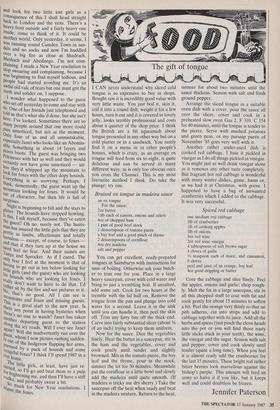The gift of tongue
a
I CAN never understand why sliced cold tongue is so expensive to buy in shops. Bought raw it is incredibly good value with very little waste. You just boil it, skin it, coil it into a round dish, weight it for a few hours, turn it out and it is covered in lovely jelly, looks terribly professional and costs about a quarter of the shop price. I think the British are a bit squeamish about tongue presented in any other way but on a cold platter or in a sandwich. You rarely find it on a menu or in other people's houses, which is crazy, as an average ox tongue will feed from six to eight, is quite delicious and can be served in many different ways, as is only too obvious once you cross the Channel. This is my most favourite method I think. Do take the plunge; try one.
Braised ox tongue in madeira sauce
an ox tongue For the sauce: 2oz butter 1/21b each of carrots, onions and celery 4oz of chopped ham
1 pint of good beef stock
1 dessertspoon of tomato purée a bay leaf and a good pinch of thyme 2 dessertspoons of cornflour 4oz dry madeira salt and pepper
You can get excellent, ready-prepared tongues in Sainsburys with instructions for time of boiling. Otherwise ask your butch- er to trim one for you. Place in a large heavy saucepan, cover with cold water and bring to just a trembling boil. If unsalted, add some salt. Cook for two hours at the tremble with the lid half on. Remove the tongue from the pan and plunge into cold water for a second. Leave it in the sink until you can handle it, then peel the skin off. Trim any fatty bits off the thick end. Carve into fairly substantial slices (about 3/8 of an inch) trying to keep them uniform. Now for the sauce. Dice the vegetables finely. Heat the butter in a saucepan, stir in the ham and the vegetables, cover and cook gently until tender and slightly browned. Mix in the tomato purée, the bay leaf and the thyme, pour in the stock, simmer the lot for 30 Minutes. Meanwhile put the cornflour in a little bowl and slowly add the madeira until quite smooth. (If madeira is tricky use dry sherry.) Take the saucepan off the heat when ready and beat in the madeira mixture. Return to the heat, simmer for about two minutes until the sauce thickens. Season with salt and fresh ground pepper.
Arrange the sliced tongue in a suitable oven dish with a cover, pour the sauce all over the slices, cover and cook in a preheated slow oven Gas 2, F 310, C 154 for 40 minutes, until the tongue is tender to the pierce. Serve with mashed potatoes and green peas, or my parsnip purée of November '85 goes very well with it.
Another rather under-used dish is cooked red cabbage. I hate it pickled in vinegar as I do all things pickled in vinegar. You might just as well drink vinegar alone as it removes any other taste completely. But fragrant hot red cabbage is wonderful with many winter dishes, game, hams or, as we had it at Christmas, with goose. I happened to have a bag of unwanted cranberries which I added to the cabbage. It was very successful.
Spiced red cabbage
one medium red cabbage llb of cranberries llb of cooking apples llb of onions 5oz red wine 2oz red wine vinegar 4 tablespoons of soft brown sugar 4 cloves of garlic
1/4 teaspoon each of mace, and cinnamon, 6 cloves
peel and juice of an orange, bay leaf 4oz good dripping or butter
Core the cabbage and slice finely. Peel the apples, onions and garlic; chop rough- ly. Melt the fat in a large saucepan, stir in all this chopped stuff to coat with fat and cook gently for about 15 minutes to soften a bit. Peel the orange very thinly so that no pith adheres, cut into strips and add to cabbage together with its juice. Add all the herbs and spices (just pinch the clove heads into the pot or you will find those nasty little sticks stuck in your teeth), the wine, the vinegar and the sugar. Season with salt and pepper, cover and cook slowly until tender (quite a long time). When you feel it is almost ready add the cranberries for the last 15 minutes. These bright red rather bitter berries look marvellous against the bishop's purple. This amount will feed an army so halve it if you like, but it keeps well and could doubtless be frozen.
Jennifer Paterson










































 Previous page
Previous page